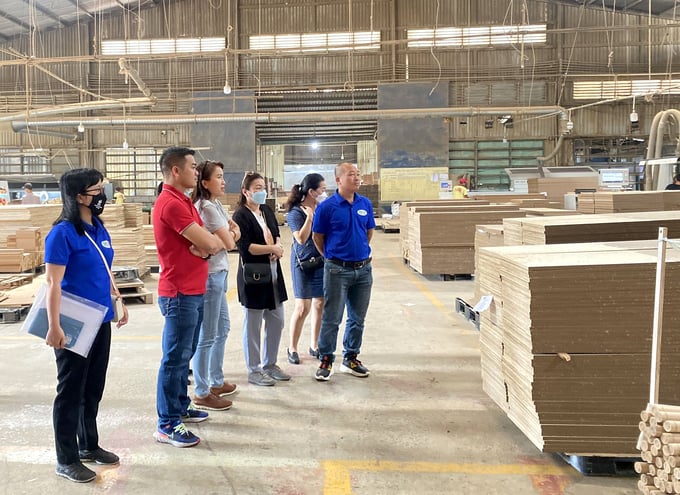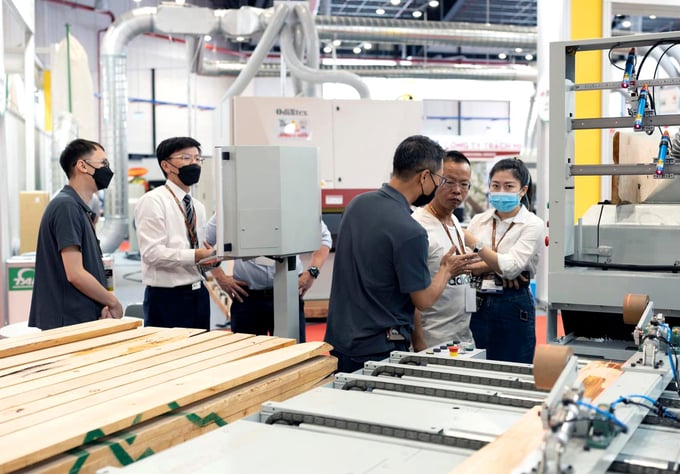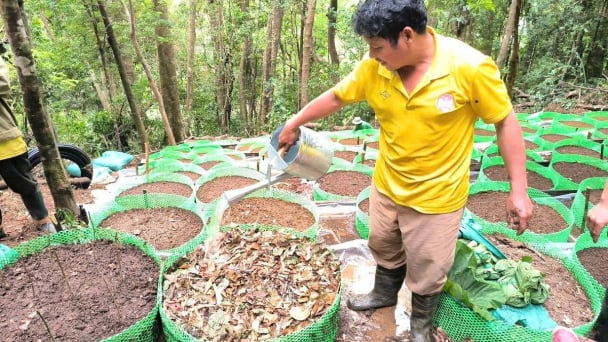May 18, 2025 | 03:49 GMT +7
May 18, 2025 | 03:49 GMT +7
Hotline: 0913.378.918
May 18, 2025 | 03:49 GMT +7
Hotline: 0913.378.918

In 2021, Binh Duong province's export of wood and wood products will reach US$ 6.12 billion, accounting for 18.6% of the province's total export turnover and 43% of Vietnam's total export turnover of wood and wood products. Photo: Nguyen Thuy.
Binh Duong is currently the province with Vietnam's largest wood processing and export industry, with a turnover of nearly US$ 6 billion in 2022. The wood processing industry in Binh Duong has continuously grown enormously for many years thanks to this province's critical position. The province is the center of the southern critical economic region, close to Ho Chi Minh City, conveniently connected to seaports and airports, and critical wood material areas in the Southeast. Besides, it is a favorable investment environment, with preferential mechanisms and policies to attract investment in Binh Duong province.
In 2022, Vietnam’s wooden furniture exports from Southeast Asian markets to Australia grew sharply in the past year, with Vietnam leading the way to US$ 205.6 million, up 26.4 percent year-on-year.
Following Vietnam is Malaysia with US$ 101.9 million and Indonesia with US$ 61.7 million.
The proportion of wooden furniture imports from these three markets accounted for 22.9 percent of the total value of imports into Australia.
Binh Duong Furniture Association (BIFA) statistics show that up to 2022, this province had 1,215 wood processing and exporting enterprises. Of these, 905 domestic enterprises with a total registered capital of nearly VND 11 trillion and 310 enterprises with foreign investment capital with a total registered capital of US$ 2.3 billion.
In 2021, Binh Duong province's export of wood and wood products will reach US$ 6.12 billion, accounting for 18.6% of the province's total export turnover and 43% of Vietnam's total export turnover of wood and wood products. Binh Duong's wood products are exported to major markets such as the US, Europe, Japan, Korea, Taiwan...
To promote the strengths of the wood processing industry and simultaneously be proactive in the face of difficulties and challenges that the Binh Duong wood industry will face, the People's Committee of Binh Duong Province has issued the Project "Development of Binh Duong's wood processing industry to 2025, orientation to 2030".
Accordingly, in the coming time, Binh Duong will develop the wood processing industry in a sustainable, efficient and modern direction based on the rational use of domestic and imported wood materials and the application of advanced technology and modern equipment, ensuring environmental standards in production, building a prestigious brand for export and domestic consumption, and promoting linkages and interactions with organizations and trade counselors in key export markets of enterprises.
With this project, Binh Duong sets an ambitious goal: By 2025, the export turnover of the province's wood processing and furniture manufacturing industry will reach US$ 9-10 billion; By 2030, it will reach US$ 12-13 billion.
To realize the set goals, Binh Duong is promoting the construction of 9 wood processing industrial clusters to form sustainable production linkages, with an average area of 70-75 ha/cluster. In which completing one industrial cluster in 2022 and continuing to complete the remaining 8 clusters before 2025.

Visitors to BIFA Wood Vietnam Expo 2022 in Binh Duong. Photo: Son Trang.
Binh Duong will arrange furniture manufacturing enterprises into industrial parks in association with mechanical product manufacturing enterprises providing supporting industrial products for the wood processing industry.
For the raw wood processing industry, Binh Duong will focus on investing in renovating advanced technology and modern equipment to produce high-quality raw materials, including investing in plant varieties to create new artificial wood materials, industrial wood;
Besides, Binh Duong wood industry will maintain and develop plantation timber material areas (rubber wood and Melaleuca wood) in localities in the Southeast and Central Highlands, forming linkages to develop wood material areas between Binh Duong province and other provinces in the Southeast region and the Central Highlands.
Binh Duong will develop supporting industries to serve the high-quality raw wood processing industry, in which priority is given to attracting large-scale investment projects, advanced technology, using less labor, creating high-quality finished products product; maintaining and expanding the domestic consumption market, and exporting high-quality wood materials.
The wood product manufacturing industry will diversify product designs for export and domestic consumption. The product structure includes high-class products made from high-grade wood (accounting for 15-20%) and high-quality products made from common quality wood (80-85%) to meet the diverse needs of customers of domestic and export consumers, building and developing brands of high-quality wooden furniture products of the province on domestic and international markets; invest in renovating advanced technology and modern equipment to produce high-quality wood products for export and domestic consumption.
Translated by Ha Phuc

(VAN) Minister of Agriculture and Environment Do Duc Duy held a meeting with Soopakij Chearavanont, Chairman of C.P. Group, on May 15.
/2025/05/16/3800-0-nongnghiep-143756.jpg)
(VAN) Suntory PepsiCo Vietnam coordinated with the Ministry of Education and Training to implement an education program on water conservation, reaching nearly 1 million primary school students nationwide.

(VAN) Vietnam’s TH Group officially put its high-tech fresh milk processing plant into operation in the Russian Federation, marking a historic moment as the first TH true MILK cartons were produced in Russia.

(VAN) Use of high-quality broodstock and biotechnology is regarded as the most effective approach to ensuring sustainable and economically viable shrimp aquaculture ahead of climate change and the emergence of increasingly intricate disease patterns.

(VAN) Carbon farming is a form of agricultural practices that helps absorb more greenhouse gases than it emits, through smart management of soil, crops, and livestock.

(VAN) This is a key content of the Memorandum of Understanding recently signed between the Vietnam Fisheries Society and Kunihiro Inc of Japan.

(VAN) To achieve the goal, local authorities and businesses in Kon Tum province have fully prepared the necessary conditions for the new Ngoc Linh ginseng planting season.